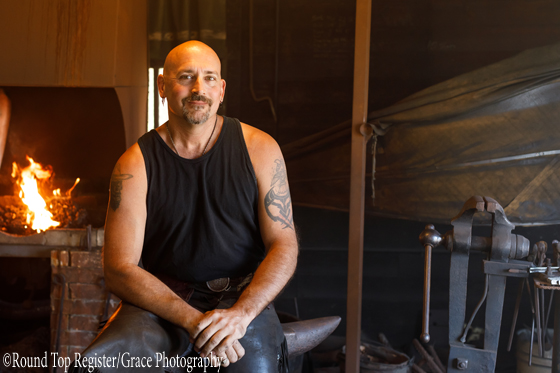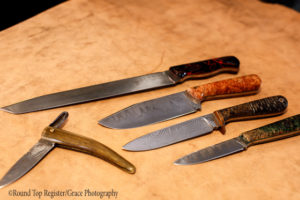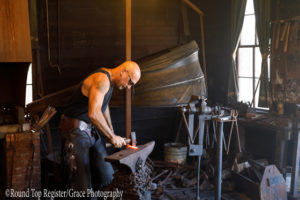Bladesmith Cowboy Szymanski Forged His Own Life

2024 Spring Antiques Show | March 14 – 31
2024 Fall Antiques Show | October 10 – 27
As owner and bladesmith at Phenix Knives in Bellville, Cowboy Szymanski has forged his own life. “Life is how you live it—and as extreme as you want it to be,” said Cowboy, who is the sole proprietor in a blacksmith shop that has been operating almost continuously since 1891.
As one of the few privately owned historic working blacksmith shops, the business is a rarity.
“I discovered early on that I hated life behind a desk but loved learning, working with my hands and using creativity to figure out how to make things,” he said. “Bladesmithing combines all of that—and it’s just fun.”
Make it Yourself
Cowboy’s curiosity, creativity—and love of knives—are products of nature and nurture.
“Knives have always intrigued me. They are the most functional tool anyone will ever own,” Cowboy said. “As a kid, King Arthur, Robin Hood and Three Musketeers captured my imagination, but my parents grounded the romance in reality.”
The family of artists, who lived in Houston’s suburbs, didn’t have a lot of extra money.
“If my brother and I wanted something, my parents said, ‘Make it,’ so we did—using whatever we could find laying around,” Cowboy said.
As a student, Cowboy struggled with the confines of traditional education because his body was as active as his mind. Sitting still and completing repetitive tasks fit neither his personality nor his learning style. After high school, he headed to Ohio for college where he studied architecture. While he loved the mechanical drawing classes and the engineering principles, he loathed the time he was tied to a desk and computer.
“I love to learn how to do new things—especially things that are practical and help me be self-sufficient,” he said. “I’ve always liked to keep moving and have fun.”
He hit the road as a professional skater with Team Rollerblade and also did a stint as a professional mountain biker. He was invited to compete in the X-Games. Instead, he retired from extreme sports and put his experience with athletics into practice by opening and managing new sporting goods stores across the nation for a variety of corporations.
Cowboy, who was then in his late 20s, had returned home to the Houston-area and was managing a local bike shop when a question—and answer—changed his life.
An older man, who regularly passed a portion of his days at the bike shop, asked Cowboy, “What do you want to do with your life?”
Without hesitation, Cowboy answered, “Make knives.”
The man responded cryptically, “You never know what’s just over your shoulder.”
And then he told Cowboy to go to the gun range that was half mile down the road and ask for Lee. Cowboy did just that on his lunch hour that day.
“The smoke was so thick when I walked into the gun range that day that I couldn’t see,” Cowboy said. “An old man at the front desk who was chain smoking cigarettes and adding to the gunsmoke cloud asked me my business. I told him I was there to see Lee.”
The old man yelled. Lee emerged from the darkness and smoke.
“He was 6’5”—an overall-wearing bear of a man whose ponytail hung below his waist,” Cowboy said. “I thought, ‘Oh shit, I’m going to die.’”
Instead of a fight, Cowboy found a reluctant teacher who hand-crafted knives under the banner of Bear Claw Knives and tried to put the eager student off by suggesting that he come back for lessons in a month or a week or even in a few days. Cowboy wouldn’t be dissuaded.
“I told him, ‘You’re missing the point. I want to learn to make knives. I’ll be here in the  morning, and I’ll leave when I can do this,’” Cowboy said.
morning, and I’ll leave when I can do this,’” Cowboy said.
He then returned to the bike shop, gave notice and the rest is history.
“I learned from Lee—and then set out to learn from everybody everywhere that I could,” Cowboy said.
His education included studying with bladesmiths across the country as well as Italy, Germany, France and Spain. He also worked as a blacksmith at living history sites across Texas such as the George Ranch in Richmond.
“I loved working on the living history sites because the staff was completely self-reliant,” Cowboy, who still maintains a collection of period costumes to use during demonstrations, said. “If we needed to build a barn, somebody would stop by my shop and order 300 nails—and I’d have to make them and whatever else we needed.”
Living with History
Cowboy first came to Bellville as an invited guest in 2003. He was working as a blacksmith in his first shop in Pasadena, and Bellville was hosting a festival called Heritage Days. The organizers asked him to demonstrate his craft in front of the town’s blacksmith shop.
“The term ‘smith’ means craftsman,” he said. “Blacksmith is the general term for craftsmen who craft the black metal.”
 In its heyday, Bellville had four blacksmiths. In 2003, the historic shop had been closed for several years. During the festival a townsman casually asked Cowboy what it would take to get him to move to Bellville and open up the shop.
In its heyday, Bellville had four blacksmiths. In 2003, the historic shop had been closed for several years. During the festival a townsman casually asked Cowboy what it would take to get him to move to Bellville and open up the shop.
“My mind was screaming, ‘Nothing. I’ll come tomorrow,’ because I’d always wanted to live in the country—and they were offering me the chance to work in a circa 1890s blacksmith shop,” Cowboy said. “But I played it cool and said, ‘Cheap rent.’”
The town’s ambassador agreed.
“In October 2003, I made one of the best moves I’ve ever made,” Cowboy said. “I found a home in a welcoming town and in a shop where the modern history of metal work from the blacksmith to the fabricator can be experienced by simply walking from my front door to my back door.”
His curiosity and creativity are also at home. Cowboy listens to audio books instead of music while he works, choosing the subjects only by what is available at the library. The titles range from mystery and romance, to how-tos. He averages four to five audio books a week, ranking him one of the local library’s most avid consumers of audio books and earning him an invitation to serve as president of the library board.
“Everything can teach you something if you’re open to it,” Cowboy said. “There’s virtually nothing I can’t make if I want to. Curiosity—and creativity—make life more fun.”
_________________________________________________________________The Reality of TV
Cowboy was tapped to compete in the first season of Forged in Fire, a reality television series on the History Channel that tested the nation’s top bladesmiths by challenging them to re-create some of history’s most iconic edged weapons. Unlike subsequent seasons where participants auditioned, all competitors for Season 1 were invited to be part of the show.
“I turned down the History Channel five times before accepting the invitation because the first contracts they sent were just so ridiculous.
I had built my business on my reputation and word-of-mouth. At the time I had 20 years invested in my business, and I wasn’t going to give a bunch of entertainment types free reign with my reputation.
After the fifth contract where we went over it line by line, the producers realized they weren’t going to get me without their full cooperation.
The night before we aired the first episode I got a bad case of ‘what was I thinking?’ after I met the seasoned bladesmiths I would be competing against. One man had been making knives as long as I’d been alive. Another had been teaching bladesmithing longer than I’d been making knives. I’d studied all of their work. And now I was competing against them on national TV.
My girlfriend talked me down and reminded me to go have some fun and let it play out as it was supposed to. It was necessary advice because the first challenge was making steel from powdered metal in a canister. I’d read about it, discussed it with people who did, but I’d never actually done it.
Instead of panicking I tried to remember ever principle of metal that I knew, moved deliberately and was hyper-attentive to every detail. Fortunately, I’d given a lot of demonstrations, so the cameras—even when there were guys down between our legs as we tried to work—didn’t distract me. I was able to stay focused.
We had to do about 70 hours of work in seven hours. The judges complimented me for being cool as ice. And my fellow competitors noticed. Peter Martin, a man renowned for his Damascus steel, told me mine was the prettiest piece on the show. Coming from him that meant a lot.
There were two big benefits of competing on Forged in Fire. First, it raised the profile of my shop. After the show I built a client base to a level where I keep a six to nine month waiting list. It’s a level that I like and can maintain.
The second, and most important to me, is that it earned me a spot in the brotherhood of elite bladesmiths. I went toe-to-toe with the best and held my own. In any field you have to earn the right for more knowledge. This was my entry point.
My fellow competitors and I left the show as friends. Since then we’ve collaborated on projects. We’ve worked in one another’s shops and shared our techniques.
Doing Forged in Fire was a good, smart move for me, but there’s not a benefit for me ever doing it again. In fact, I decided not to pursue another show offer sent to me just last week. To people who criticize me for not going at it again, I say, ‘Come talk to me after you’ve done it the first time.’”
______________________________________________________________________________by Lorie A. Woodward
photos by Anna Spencer Morse, Grace Photography
2024 Spring Antiques Show | March 14 – 31
2024 Fall Antiques Show | October 10 – 27